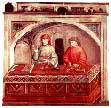FRANCESCO DI MARCO DATINI/4
74 Kb.

His continual movement between Prato and Florence was extended
to a new place further north. To escape one of the many outbreaks
of the plague, he had taken shelter with his family at Pistoia
in 1390, remaining there until the 17 May of the following year.
135 Kb.

Datini was forced to considerably greater movement at the end
of the century because the plague was still rife.
It had been presaged in September '99, claimed numerous victims in Venice and Bologna and then it pervaded the countryside around Florence and the city itself.
When Bologna was finally free of the terrible disease, Francesco decided to move there, together with his family, his main partner (Stoldo di Lorenzo) and some stewards.
It had been presaged in September '99, claimed numerous victims in Venice and Bologna and then it pervaded the countryside around Florence and the city itself.
When Bologna was finally free of the terrible disease, Francesco decided to move there, together with his family, his main partner (Stoldo di Lorenzo) and some stewards.
96 Kb.

In Bologna, where Datini remained for about a year, other Tuscan
economic operators also sought refuge; the Florentines Filippo
Tornabuoni, Piero Bonciani and Antonio di Niccolò da Uzzano,
Bartolomeo Balbani from Lucca and Giovanni di Feo Bracci from
Arezzo. All of them forged tight bonds with the most illustrious
personages of the area, but they kept their individuality as
a "Tuscan colony".
84 Kb.

On his return to Prato on the 20 September 1401, Datini noticed
the many blank spaces among his collaborators: Bartolomeo Cambioni,
the banking specialist, Niccolò di Piero, the industry
specialist, Manno d'Albizzo, the specialist of the Pisa
area, Andrea di Bonanno, the specialist of the Genoa area - all
of them carried off by the plague. On the other hand however,
unfavourable situations still advanced in the political situation
in Florence (suffice it to remember the Visconti encirclement
and the siege of Pisa).
69 Kb.

So Francesco shut down the two industrial companies and his banking
concern, together with those at Pisa and Genoa. The other companies
continued until 1410, whilst the one in Florence lasted for another
five years after his death, with the purpose of further increasing
his hereditament with its profits, waiting for the winding-up
of the whole system.
51 Kb.

Francesco Datini died on the 16 August 1410. He was buried in
the church of San Francesco, and his tombstone (carved by Niccolò
di Piero Lamberti, known as "Pela", and recently restored
by the Associazione "Il Cenacolo") can still be seen
at the centre of the church.
After the legacies left to his relatives, protégés, friends and companions, the newly-established "Casa e ceppo de' poveri di Francesco di Marco" to which he left his estate, was able to count on an estate of over 100,000 florins.
After the legacies left to his relatives, protégés, friends and companions, the newly-established "Casa e ceppo de' poveri di Francesco di Marco" to which he left his estate, was able to count on an estate of over 100,000 florins.